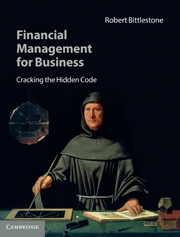Book contents
- Frontmatter
- Contents
- List of figures
- Introduction
- Acknowledgements
- Part 1 A dream of future wealth
- 1 Income and outcome
- 2 Fool's gold
- 3 Play the game
- 4 The judgment of balance
- 5 Return to reality
- 6 The cost of success
- 7 Profit and cash
- 8 Time to take stock
- 9 A capital asset
- 10 Mind your own business
- 11 The taxonomy of fog
- 12 The Merchant of Florence
- Part 2 The hidden art of management
- Appendix 1 Mathematical anchor
- Appendix 2 Getting to grips with cash
- Postscript
- Bibliography
- Index
12 - The Merchant of Florence
from Part 1 - A dream of future wealth
Published online by Cambridge University Press: 05 June 2014
- Frontmatter
- Contents
- List of figures
- Introduction
- Acknowledgements
- Part 1 A dream of future wealth
- 1 Income and outcome
- 2 Fool's gold
- 3 Play the game
- 4 The judgment of balance
- 5 Return to reality
- 6 The cost of success
- 7 Profit and cash
- 8 Time to take stock
- 9 A capital asset
- 10 Mind your own business
- 11 The taxonomy of fog
- 12 The Merchant of Florence
- Part 2 The hidden art of management
- Appendix 1 Mathematical anchor
- Appendix 2 Getting to grips with cash
- Postscript
- Bibliography
- Index
Summary
There is nothing more difficult to take in hand, more perilous to conduct, or more uncertain in its success, than to take the lead in the introduction of a new order of things.
Niccolò MachiavelliFailing to understand the difference between profitability and cash flow is a prime cause of bankruptcy. You will almost certainly experience virtual bankruptcy first-hand in Part 2, so let me offer you some light relief as an antidote to your forthcoming mortification.
I wrote the following fantasy for Chief Executive magazine in September 1991, at a time when leveraged management buy-outs had bequeathed the legacy of an unsustainable debt burden on newly spun-out companies. In a way that foreshadowed the dot.com bankruptcies ten years later and also the recent ‘credit crunch’, vague forecasts of profit rather than solid achievements of cash were felt to be king. But I must emphasise that this chapter is presented for your entertainment rather than your education: you can ignore it without peril.
Dramatis Personae
Prince Machiavelli, a Florentine business tycoon hell-bent on expansion.
Luca Pacioli, inventor of double-entry book-keeping and financial adviser to the Prince.
Leonardo da Vinci, amateur inventor and occasional artist.
- Type
- Chapter
- Information
- Financial Management for BusinessCracking the Hidden Code, pp. 79 - 82Publisher: Cambridge University PressPrint publication year: 2010



